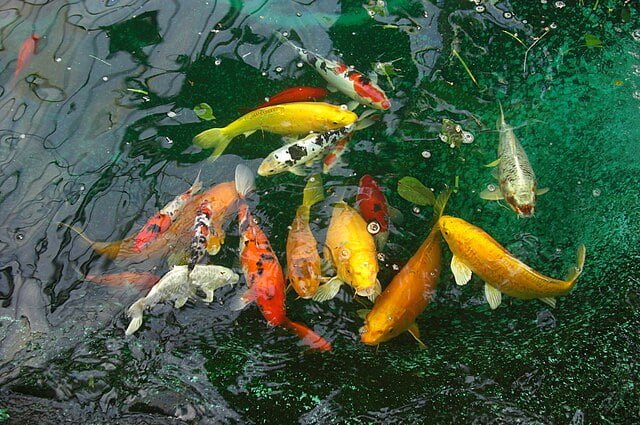
Carp farming, currently contributing to approximately 50% of inland water aquaculture production, plays a pivotal role in ensuring global food security. Several species of carp, including herbivorous carp (Ctenopharyngodon idella), silver carp (Hypophthalmichthys molitrix), common carp (Cyprinus carpio), bighead carp (Hypophthalmichthys nobilis), catla (Catla catla), and rohu (Labeo rohita), are fundamental to this industry. However, to ensure the long-term sustainability of carp farming and mitigate its environmental impact, exploring alternative and environmentally friendly systems is essential.
In this context, researchers from the University of Jiroft and the Iranian Fisheries Sciences Research Institute, Agricultural Research, have published a scientific review emphasizing the significance of biofloc technology in carp aquaculture.
Biofloc Technology: A Turning Point in Carp Farming
Biofloc Technology (BFT) has gained prominence for its ability to maintain a healthy and sustainable aquaculture environment. This innovative approach relies on controlling toxic metabolites by introducing a cost-effective carbohydrate source into the culture system.
The result is the formation of bioflocs, unique ecosystems characterized by densely packed particles suspended in the water. Despite their seemingly poor water quality, these systems are rich in crude protein, essential minerals, and essential fatty acids that are highly beneficial for carp nutrition.
Bioflocs in Carp Farming
Biofloc technology significantly influences various aspects of carp farming, providing a sustainable and eco-friendly solution to meet the ever-increasing demand for this essential food source. The scientific review delves into key aspects of using biofloc technology in carp aquaculture:
Water Quality
Bioflocs actively contribute to improving water quality within the rearing system, removing toxic metabolites and ensuring a cleaner and healthier environment for carp growth.
Growth Performance
Carp raised within biofloc systems often exhibit improved growth rates, resulting in a more efficient conversion of nutrients into biomass and enhanced production efficiency.
According to the study, biofloc treatments significantly reduce feed conversion ratios and enhance the growth performance of common carp and crucian carp, among others.
Stay Always Informed
Join our communities to instantly receive the most important news, reports, and analysis from the aquaculture industry.
“In general, biofloc technology has demonstrated its potential to improve fish production and quality in a more sustainable and cost-effective manner,” report the authors of the study.
Immune Responses
Carp raised in BFT systems tend to display robust immune responses, making them more resilient to diseases and stressors. Various studies have documented the immune-stimulating effects in carp aquaculture.
Additionally, the presence of bioflocs and associated microorganisms provides a rich source of antioxidants, contributing to better health and resilience in cultivated carp.
“Certain constituents of the biofloc, such as heterotrophic bacteria, have been identified as probiotics and immune stimulants that activate the non-specific immune system,” cite the researchers.
Digestive and Hepatic Enzyme Activity
Scientific literature reports that carp cultivation in biofloc systems has a positive impact on digestive enzyme activity. The stimulation of digestive enzymes positively affects digestion, nutrient utilization, and growth.
Furthermore, the presence of biofloc alters the intestinal flora and microbial communities, including beneficial bacteria, microalgae, and plankton, contributing to the stimulation of digestive enzymes.
Body Composition
Carp raised in biofloc systems exhibit a favorable body composition, with higher levels of essential nutrients beneficial for human consumption.
According to the researchers, the increased levels of protein and lipids in carp cultivated in a biofloc system can be attributed to the absorption of essential fatty acids, amino acids, vitamins, and minerals available in the flocs.
Conclusion
Biofloc technology represents a significant alternative in carp aquaculture. “The benefits of carp farming in biofloc systems are extensive. Improved water quality, feed conversion ratios, feed utilization, protein digestion, and retention are some of these advantages,” conclude the researchers.
They also emphasize that the presence of bioactive compounds in bioflocs increases several parameters, such as immune activity, antioxidant levels, and fish biochemical composition.
As the aquaculture industry actively promotes and implements the use of BFT, it takes significant steps toward a more sustainable, efficient, and eco-friendly future.
In a world where the need for sustainable food production is paramount, carp farming in biofloc systems offers a compelling solution.
Contact
Mohammad Hossein Khanjani
Department of Fisheries Sciences and Engineering
Faculty of Natural Resources, University of Jiroft
Jiroft, Kerman, Iran
Emails: m.h.khanjani@ujiroft.ac.ir, m.h.khanjani@gmail.com
Referencia (acceso abierto)
Mohammad Hossein Khanjani, Moslem Sharifinia, Saeed Hajirezaee. 2023. Biofloc: A sustainable alternative for improving the production of farmed cyprinid species, Aquaculture Reports, Volume 33, 2023, 101748, ISSN 2352-5134, https://doi.org/10.1016/j.aqrep.2023.101748.
Editor at the digital magazine AquaHoy. He holds a degree in Aquaculture Biology from the National University of Santa (UNS) and a Master’s degree in Science and Innovation Management from the Polytechnic University of Valencia, with postgraduate diplomas in Business Innovation and Innovation Management. He possesses extensive experience in the aquaculture and fisheries sector, having led the Fisheries Innovation Unit of the National Program for Innovation in Fisheries and Aquaculture (PNIPA). He has served as a senior consultant in technology watch, an innovation project formulator and advisor, and a lecturer at UNS. He is a member of the Peruvian College of Biologists and was recognized by the World Aquaculture Society (WAS) in 2016 for his contribution to aquaculture.




